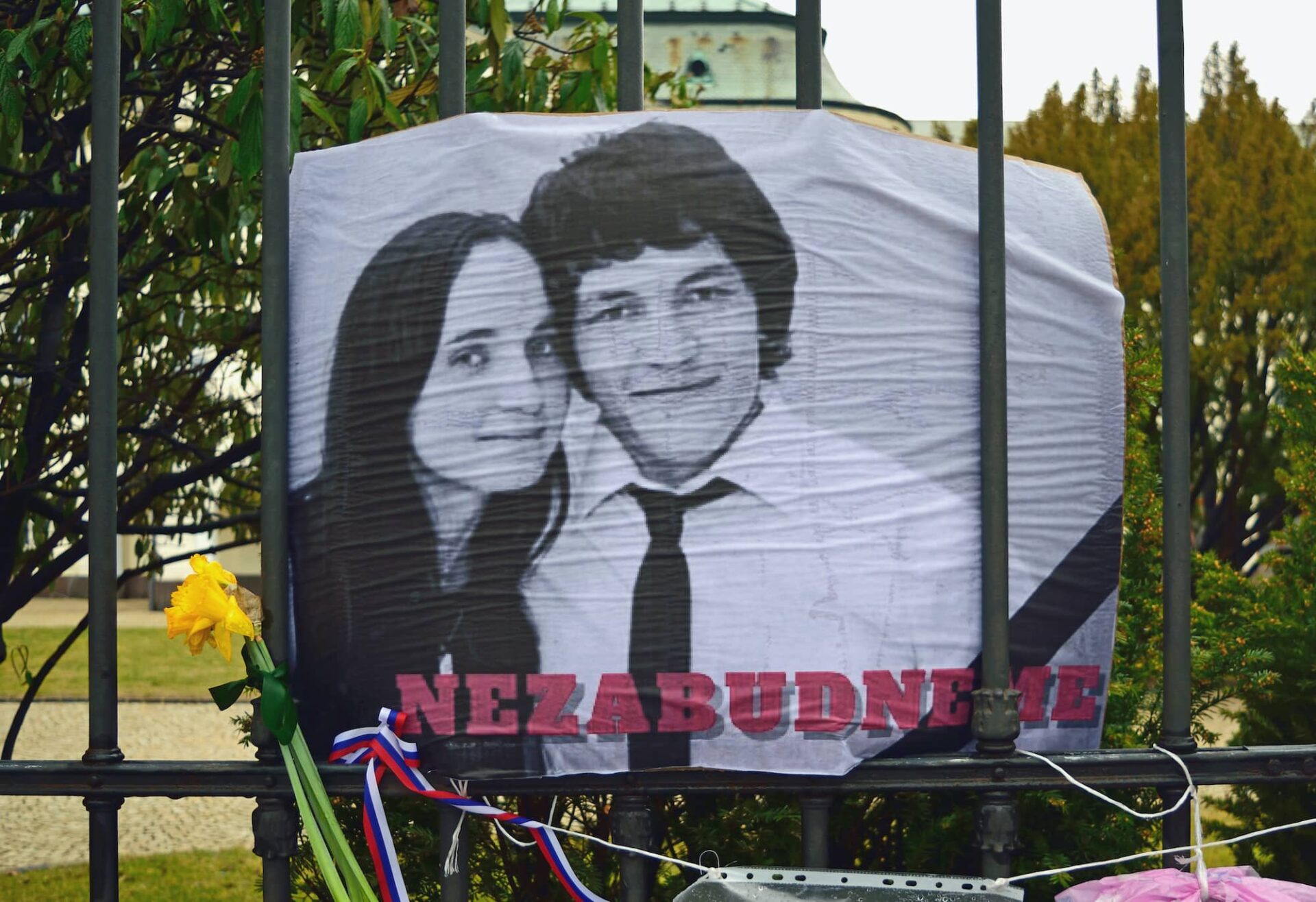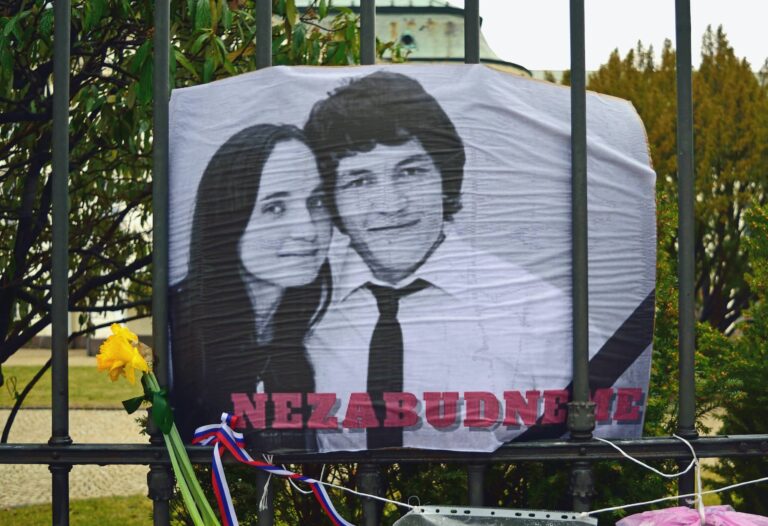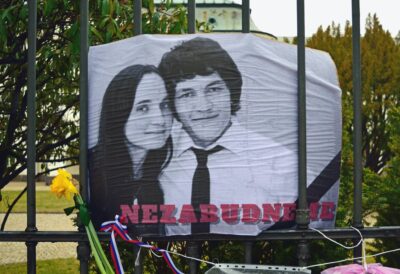On Tuesday, the Supreme Court of the Slovak Republic will issue a judgment in the case of the February 2018 murder of investigative journalist Ján Kuciak and his fiancée, Martina Kušnírová. The killing shocked Slovakia and led to the fall of Prime Minister Robert Fico of the Smer-SD party and later, in the February 2020 parliamentary elections, to the landslide victory of the opposition, which ran on an anti-corruption platform.
Two people involved in the murder of investigative journalist Ján Kuciak and his fiancée, Martina Kušnírová, have already been sentenced to long prison terms. Zoltán Andruskó, the middleman between the masterminds and the killers, who confessed and helped investigators uncover the murder plot, is serving 15 years in jail. The triggerman, Miroslav Marček, also confessed and is serving 23 years in prison.
The fates of the other defendants are in the hands of the Supreme Court, which will decide on the appeals. The killer’s driver, Tomáš Szabó, continues to deny his involvement in the crime, but the court of first instance found him guilty, and he was given 25 years.
However, a panel from the Specialized Criminal Court in Pezinok, consisting of judges Ružena Sabová, Ivan Matel, and Rastislav Stieranka, acquitted Alena Zsuzsová and Marian Kočner, the alleged mastermind behind the murder. In acquitting them, these judges cited the in dubio pro reo principle (where there is doubt, favour the accused).
Kočner is currently serving a 19-year prison sentence for fraud in an unrelated case, and Zsuzsová is in custody on charges of ordering the murders of two prosecutors and an attorney through the same middleman convicted for involvement in Kuciak’s murder.
Whether Kočner – about whom Kuciak often wrote, infuriating Kočner – and Zsuzsová, who worked as Kočner’s associate and who allegedly ordered the journalist’s murder at Kočner’s behest, are guilty or innocent is now in the hands of the Supreme Court.
The Supreme Court, which will decide on the appeals on Tuesday, has three options. The judges may conclude that there is insufficient evidence to sentence Kočner and Zsuzsová and that the principle of in dubio pro reo must be respected. Kočner and Zsuzsová would thus be acquitted for good.
Or they may decide that it is necessary to present additional evidence to the court of first instance, overturn its judgement, and thus return the case to the panel led by Ružena Sabová. Alternatively, it may order a new trial and hearings, in which case the matter would probably be decided by different judges from the Specialized Criminal Court. In his appeal, the prosecutor requested the case be retried by a different panel of judges than the one that acquitted Kočner and Zsuzsová.
The prosecutor’s office as well as the parents of the victims are appealing the first-instance court’s decision. In the appeal, Kuciak’s family emphasizes the emotional damage they have suffered by the brutal death of their beloved son and brother. “Ján Kuciak was a role model for and mentor to his younger brother, Jozef . . . . He was able to talk to his parents – Jozef and Jana – for hours,” they wrote in the appeal. This is also why the prosecutor is demanding an even stricter sentence for Tomáš Szabó: life imprisonment.
Through her lawyer, Roman Kvasnica, Martina’s mother, Zlata Kušnírová, has also asked for additional evidence to be presented in the hearings – for example, the USB stick that the police secured during a search of Kočner’s villa in Bratislava, on which materials related to the surveillance of Ján Kuciak by Kočner’s spies are stored.
The information contained on this flash drive could have had an impact on how the Specialized Criminal Court evaluated the testimony of Zoltán Andruskó. A panel of judges from the court of first instance believed Andruskó’s testimony against his cousin Szabó, but not against Zsuzsová and Kočner. Our analysis of his statements and testimony suggests that since the day he was first detained, Andruskó has consistently described how the murder was ordered and took place, and has always spoken of photographs and text files that Zsuzsová allegedly showed him as part of the contract for Kuciak’s murder. Andruskó has described a document and photographs that are strikingly reminiscent of the materials prepared by Kočner’s surveillance team found on the USB drive.
The prosecutor has also objected to the court of first instance’s claim that Andruskó is a less credible witness because he confessed and testified against other people. The fact is that Andruskó received a sentence that was five years longer than he had originally expected in exchange for his cooperation (ten years), but he nevertheless has continued to cooperate. Moreover, if he provided false testimony to the court, he would have only been damaging his own interests, as if it were ever proven he lied during such testimony, he could forget about being granted parole.
Zlata Kušnírová also requested in the appeal that evidence demonstrating Kočner’s violent tendencies be presented because, according to the court of first instance, it was not proven that Kočner wanted to resolve his dispute with Kuciak violently. She wants the court to conisder messages sent by Kočner to Jaroslav Haščák, about “fucking getting rid of a dick”, and to a race car driver, to whom he wrote that Kuciak would “get the shit beaten out of him”.
In the appeal, the prosecutor criticizes the panel led by Ružena Sabová for mistaking public interest in the trial for media pressure. According to him, no external pressure on the court “existed, nor does it exist now”. The prosecutor even suspects that the court decided to acquit Kočner and Zsuzsová only “to show that it did not succumb to media pressure”.
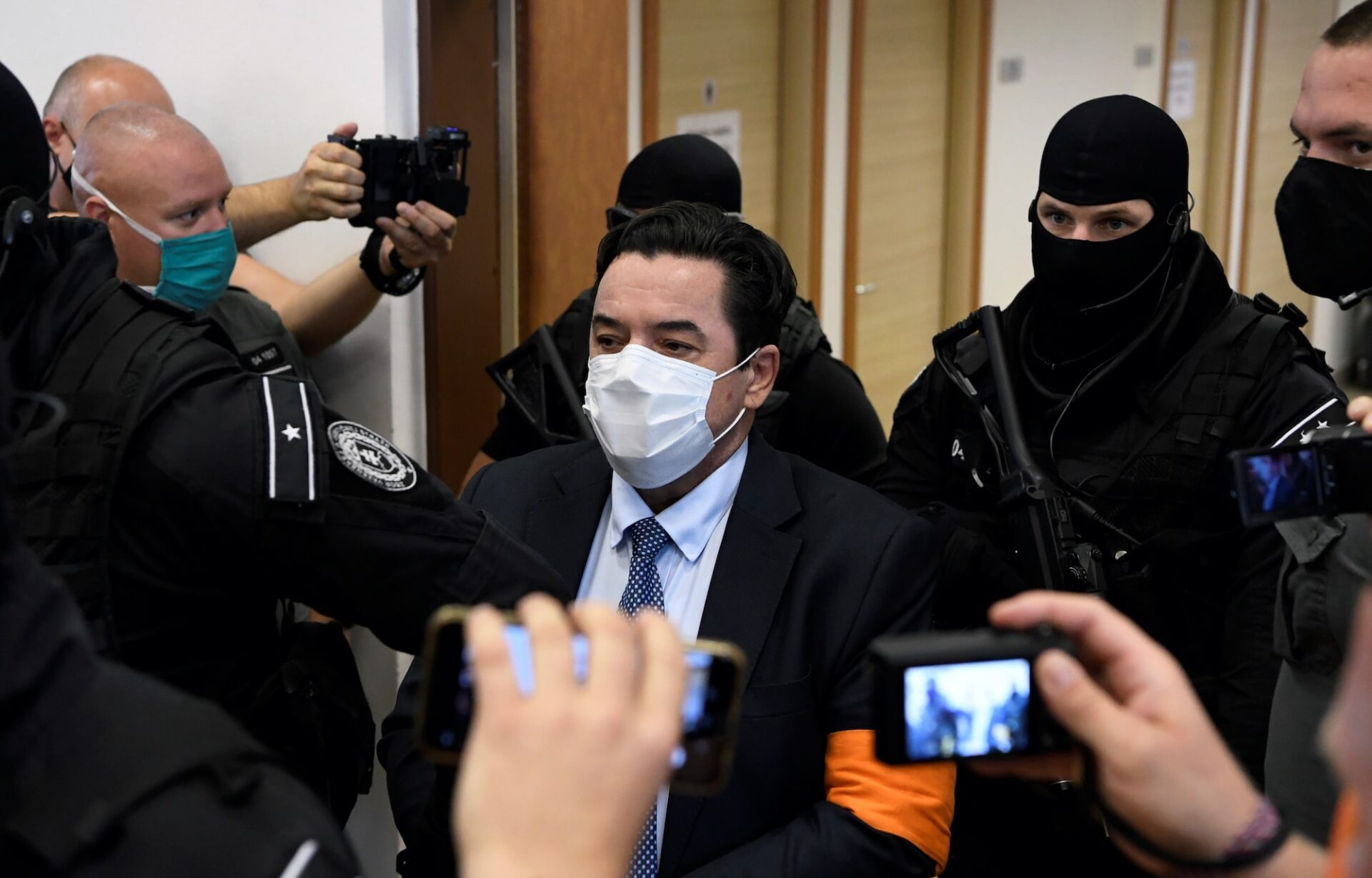
Marian Kocner, accused of ordering and carrying out the murders of investigative journalist Jan Kuciak and his fiancee Martina Kusnirova, walks inside the courtroom to receive his verdict in Pezinok, Slovakia. September 3, 2020 Source:: RADOVAN STOKLASA / Reuters / Forum
The prosecutor also suggests the court considers some completely new evidence – an analysis of Zsuzsová’s heartbeat at the time of the murder, obtained from her fitness tracker, and the expert opinion of Comenius University linguists who have analyzed communication between Kočner and Zsuzsová. According to these experts, the messages were full of ciphers and metaphors.
For example, the linguists have pointed out discrepancies between the events described in their exchanges and what happened in real life. For example, Zsuzsová sent messages about losing teeth or visiting a dermatologist for itching, but her teeth did not fall out nor was she seen by a doctor. According to the experts, these were coded messages conveying something else. So, what could such messages possibly mean? Dream dictionaries, for example, interpret dreams about a tooth falling out to mean that you will learn about someone’s death.
The Comenius University experts have also commented on Kočner’s and Zsuzsová’s use of emojis, which commonly express emotions in messages. In Kočner’s communications to Zsuzsová, however, “some emojis do not express emotions, but carry additional meaning… In several conversations, such emojis are not semantically related to the main topic and could therefore be references to secret meanings.”
An example of such coded emojis comes from one message composed of emojis reading “50” and “SOON” and one of the grim reaper. The prosecutor claims that the price for Ján Kuciak’s murder was 50,000 euros.
A fateful article
It is June 2017. Investigative journalist Ján Kuciak has just published an article on the Aktuality.sk news site titled “The Kočner Case: We Have Found Strange Practices during the Investigation”. This was not Kuciak’s first or last article about a man whom the media was still calling a “controversial businessman” at the time.
However, this article hurt Kočner more than the others. But it wasn’t just the businessman’s reputation that was being damaged. In the article, Kuciak drew attention to several missteps made by police officers from the National Unit of the Financial Police who investigated possible tax fraud involving properties owned by Kočner in the ski resort of Donovaly. Afterwards something rare happened in Slovakia — the authorities began to act. Kočner was charged on 21 September 2018 in the Donovaly case.
Two and a half years later, Kuciak’s colleagues, who were called to the stand before the Specialized Criminal Court in Pezinok, agreed that this article may have been one of the reasons for his murder. “[Kočner] did not know how to put an end to the articles that revealed what he probably had been doing for a long time,” Ján Petrovič, a journalist from Aktuality.sk, told the court.
Putting journalists under surveillance
In the first half of 2017, the monitoring of several journalists began. At the behest of Kočner, Peter Tóth, a former journalist, former member of the secret service, and Kočner’s friend, organized this surveillance operation. After Kuciak’s murder, when investigators began focusing on Kočner, Tóth made a U-turn and started cooperating with the police.
Tóth provided testimony about the murder of Ján Kuciak and Martina Kušnírová, first as an anonymous witness and later under his own name. In his statements, he claimed that Kočner had already assigned him to follow journalists, including Kuciak, sometime in late 2016 or early 2017. Kočner gave him a list of the names of journalists he wanted to follow in a text document.
Among the documents stored on Kočner’s electronic devices that were seized by the police during searches and which we gained access to thanks to the “Kočner’s library” project, there is a file titled “edgar_objects”. It seems that “Edgar” was the cover name for the whole operation. This may be a reference to John Edgar Hoover, the first director of the FBI, who was also known for spying and collecting compromising information on several prominent US figures of the time.
The file “edgar_objects” contains the names of 28 people whom Kočner considered important enough to deploy his own spies on them. Ján Kuciak, however, is not among them.
According to Tóth’s statements, Kočner also procured information on these people from police databases to facilitate the surveillance team’s work. The police file on the murder case suggests that Kočner may have obtained this official information thanks to his relationship with an oligarch close to then-prime minister Robert Fico’s Smer-SD party, Norbert Bödör. The oligarch, however, denied any part in the surveillance of the journalists.
Kočner also claimed before the court that the purpose of the surveillance campaign, on which he spent tens of thousands of euros, was to search for compromising information, tabloid pictures, which he would then publish on his portal, whose Facebook page was created only after Kuciak’s murder.
The members of the surveillance team, including Tóth and Kočner, were charged in relation to this spying on journalists in March 2021 with “breaching the confidentiality of utterances and other other personal expressions”.
The monitoring of journalists started in the first half of 2017, and Tóth regularly provided reports and findings to Kočner stored on USB sticks. On those that the police managed to secure, there are folders titled “Edgar”, which include photographs, videos, audio recordings, and professional-looking text documents with embedded photographs describing surveillance operations.
However, Kuciak was not yet among those monitored at that time.
Illegal accessing Kuciak’s personal data
A police officer illegally accessed personal data about Kuciak from police databases on 7 September 2017, including information about Kuciak’s house in Veľká Mača, his permanent residence, which he and his fiancée, Martina Kušnírová, had bought and renovated earlier in 2017. On a printed data sheet about Kuciak, however, his address was given as only “Veľká Mača, Galanta”; the street and number were missing. That is probably why Pavol Vorobjov, the policeman who ordered the information, pulled data on Kuciak again from another police database on 25 September 2017. This system probably provided Kuciak’s exact address.
In his first statement, Vorobjov said he received the order to provide information about Kuciak from Tibor Gašpar, the then-president of the police force. Less than six months later, however, Vorobjov gave another statement, changing his previous claims. “In previous testimony, I said that it was a request from Mr. Gašpar, but in hindsight I must say that this was a presumption on my part because I just do not remember where the request came from,” Vorobjov said.
Gašpar is a distant relative of oligarch Norbert Bödör, and according to later charges brought by the police, they were both members of an organized crime group headed by Bödör.
Several of the statements made by Peter Tóth and the policemen who accessed data on Kuciak contain information that we found to be false. In general, they tried claiming that everything happened sooner than it did, that the first order to provide information about Kuciak came in August, or even in February. Why?
The date of when Kuciak’s data were accessed is important: it was done on 7 September 2017, two days after Kočner threatened Kuciak over the phone: “I will start paying special attention to you and your person, your mother, your father and your siblings.”
Information about Kuciak was last accessed on 25 September 2017, four days after Kočner was charged in the Donovaly case.
Kuciak’s surveillance could begin.
Kuciak’s address
In his court statement, Tóth claimed that Kuciak’s real address was discovered by following him. That is why they allegedly waited for Kuciak in front of the Aktuality.sk editorial office, from where they followed him to Veľká Mača.
That things could have been otherwise is indicated by the fact that on 3 October 2017 at 3:17 p.m. Kočner sent Tóth Kuciak’s address in Veľká Mača via the Threema application, even though Tóth said in court that at that time the surveillance team had already figured out the address.
We also know that Kočner met with Bödör on the same day in the morning, Bödör being — according to current allegations — the head of an organized crime group, which supposedly included the former police president, Gašpar, who, according to Vorobjov’s first statement, ordered the file on Kuciak.
“We’ll talk tomorrow,” Kočner wrote to Bödör via Threema the day before. On the morning of 3 October 2017, Bödör also wrote to Kočner, telling him in which restaurant in Bratislava he was sitting and where Kočner would find him: “When you enter inside, to the left, behind the screen.”
Tóth testified in the murder case that Kočner sent him Kuciak’s address in Veľká Mača on 3 October 2017. But he claimed that the surveillance team already knew it because they found it out by tracking Kuciak. However, their reports on Kuciak do not begin until 4 October 2017.

A report from the first day of monitoring Ján Kuciak. Source: OCCRP / Kočner Library
Not only the surveillance operation but also the very idea of monitoring Kuciak was most likely born when telephone threats were being made. In a phone call, Kočner really said that he was going to “find dirt” on Kuciak.
But according to the members of the surveillance team, their spying work did not reveal any misconduct. “Miroslav Kriak informed me that it doesn’t make any sense, that Ján Kuciak has no social life. He sits in the newsroom for ten or twelve hours, he goes to the bus in the evening, eats a baguette, and then turns on the cement mixer over the weekend. He said that the boy lived like a monk,” said Tóth in front of the Specialized Criminal Court during the murder trial.
The contract
In his statements, Tóth reaffirmed that he handed over surveillance materials to Kočner on USB sticks on a regular basis – before the murders and once again everything all together after the killings.
These memory sticks were indeed found in a vault in Kočner’s house in Bratislava’s Chrasťova Street. The folders on the sticks were titled after the people being spied on. They contained photos and sometimes videos and audio recordings. Written reports were also included.
These text documents were prepared by one of Kočner’s and Tóth’s spies, Miroslav Kriak, a former member of the secret service, in both the Communist and democratic eras.
The text usually describes what was observed on individual days – when and where the monitored person was seen, where they went, with whom they met. The documents are supplemented by photographs, which are inserted into the text.
However, the seized flash drives were not considered as evidence during the trial of the murder of Kuciak and Martina Kušnírová before the Specialized Criminal Court in Pezinok. This is also pointed out in the appeal filed by Zlata Kušnírová’s lawyer, Roman Kvasnica, against the acquittal of Zsuzsová and Kočner.
The perpetrators of the murder received information from their clients about the target, including photographs of him. This was confirmed by the middleman, Zoltán Andruskó, and the shooter, Miroslav Marček. However, the court of first instance did not believe Andruskó or the prosectutor’s arguments that these photos were received by the perpetrators of the murder from Zsuzsová, who had them from Kočner, who in turn got them from Tóth.
The credibility of Andruskó’s testimony is a key issue that the Supreme Court must also address. In its judgment, the panel of judges from the Specialized Criminal Court considered his testimony against Tomáš Szabó to be credible, but not his statements against Kočner and Zsuzsová.
However, Andruskó provided statements on several occasions – for the first time on the evening of 27 September 2018, the day he was detained in his house by the police. In other statements though he changed the details. Kočner’s and Zsuzsová’s defenses were built on these changes, alleged proof that Andruskó is not credible. However, Andruskó’s statements always clearly linked Kočner to the murder
After Andruskó was detained, he was taken to Bratislava. At 10:15 p.m., his first interrogation began. The transcript reveals that he was quite shaken after being detained. But it also clearly indicated a significant connection between Kočner and the murder of the investigative journalist and his fiancée.
Police questioning usually consists of two parts. At the beginning of an interrogation, the witness speaks spontaneously – they say what they want to say about the matter. Only then does the investigator ask specific questions. At the very beginning of his spontaneous statement, Andruskó said that Kuciak’s murder was ordered by “Mrs. Alena”, who also told him “the name of the person for whom she was facilitating [the murder], but I am afraid to give that name because I am worried for my life. And the life of my family… This person… has an awful lot of influence and money, and his name is Marian Kočner.”
According to Andruskó, the order was given in a car parked in front of Zsuzsová’s house: “Alena had a text, and she took photos of it with a phone that I gave her. I took the phone. On that phone were photos of data about the murdered Ján Kuciak… That text, it was professionally written, so the person who wrote it must have had well researched information because there were photos of Kuciak and his address in Veľká Mača and other information about him… Based on those photos, someone had to have followed him before…”.

Part of a surveillance report on Ján Kuciak, proving that his exact address and the number plate of his car were mentioned several times in the reports. Source: OCCRP / Kočner Library
In his first statement, made the night after his arrest before he could be acquainted with any other evidence and see photographs contained in the file, Andruskó spontaneously described the surveillance reports. In further statements made on 28 September 2018 and 18 October 2018, the details changed, but Andruskó described the text file containing data about Kuciak and photographs of him, which Zuszsová had shown him, in a similar way. It seemed to him to be a professionally crafted report, with embedded photographs, that contained Kuciak’s home address. His description is strikingly reminiscent of the reports prepared by Miroslav Kriak for Peter Tóth, who passed them on to Kočner.
In mid-October 2018, the police raided Kočner’s villa in Chrasťova Street in Bratislava, where they found, among other things, USB keys, which contained reports from surveillance operations targeting journalists, including Ján Kuciak. The very next day, on 18 October 2018, Andruskó provided further statements, claiming he recognized one of the photographs that the officers showed him — one they found on the USB drive from Kočner’s villa.

A photograph from the surveillance file on J. Kuciak, which Zoltán Andruskó recognized. Source: OCCRP / Kočner Library
Kriak, who in a statement made in April 2019 confirmed that he wrote the text files, also recognized the text file from that USB drive during his testimony to be one that he wrote. In April 2019, investigators showed these photos to the triggerman, Miroslav Marček, who also recognized several of them.
The murder
In statements made to investigators, Marček claimed Andruskó showed the photos to him and his cousin Tomáš Szabó sometime in late 2017 or early 2018. From these photos, the killers wrote down information about Kuciak, including his address.
Szabó and Marček travelled to Veľká Mača for the first time on 5 February 2018. Two days later they revisited in the morning and in the afternoon, and again on 10 February 2018 in the early evening. On their fifth trip, made on 15 February 2018, they also took Andruskó with them. The next day, they returned, and Marček walked the route to the victims’ house. On 17 February 2018, Andruskó provided them with mobile phones, which they used on the day of the murder.
In the meantime, Marček got a weapon with a modified barrel, a silencer, and ammunition, in which he reduced the amount of gunpowder to make it quieter. This meant the weapon would no longer be semi-automatic; after each shot it had to be loaded, but it was just as deadly. According to Marček, Szabó assisted in procuring and testing the weapon.
Armed with this gun, Marček went to the journalist’s house in Veľká Mača on 19 February 2018, but changed his mind. “It was in the evening, but I turned around. There was another person in the house,” he later described in court.
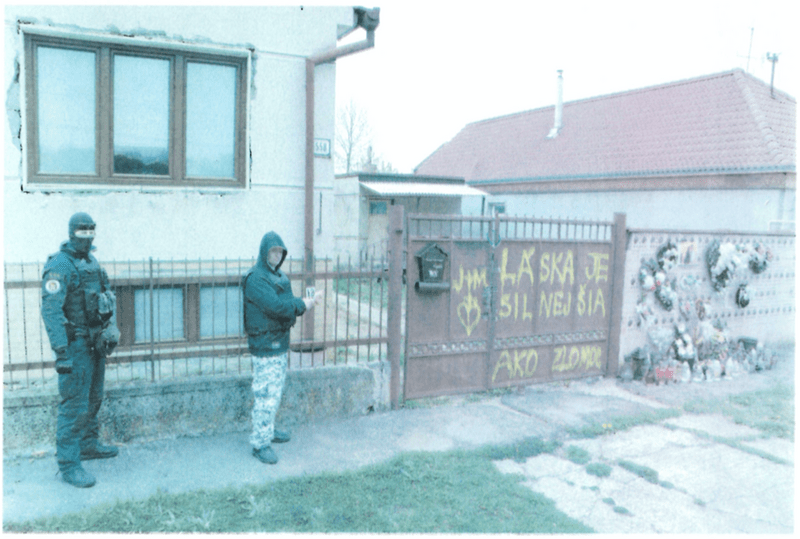
Miroslav Marček during the reconstruction of the crime in front of the house in which he murdered two people. Source: OCCRP / Kočner Library
Two days later though he did not hesitate. In the evening, Szabó dropped him off in Veľká Mača, and Marček walked to the house and hid in the summer kitchen, where he waited for almost two hours. Then he knocked on the main door. He murdered Ján Kuciak and Martina Kušnírová. “It was not possible to just leave from there; I was not wearing a balaclava,” he said to the court, explaining why he had killed Ján’s fiancée too, even though her murder had not been ordered.
After the murder, he called Szabó on his work mobile phone, who then picked him up at an agreed-upon place. They left Veľká Mača together. They reported the act to Andruskó, who then allegedly informed Zsuzsová. Szabó still claims that he knew nothing about the murder and was convinced that his cousin was only going to beat up the journalist.
The bodies lay there for days, before Martina’s mother began to suspect something and alarmed the police. On 26 February 2018 all of Slovakia learned about what had happened. After the news broke, Kočner and Zsuzsová met in Báč.
We do not know what was going through their heads or what they were trying to discuss. But forces had just been set in motion that would not only lead to this once mighty businessman’s fall from grace but that would also change Slovak society forever.
This force would reveal the full extent of high-level corruption and the control that the mafia had over the state, including the police and the judiciary. There is a term in political science for what we learned the Slovak state to be: a “captured state”.
Learning the full extent of what was wrong was the absolutely necessary first step towards healing the state and society. But the price we had to pay was still too high.
Cover photo: Marian Kocner, accused of ordering and carrying out the murders of investigative journalist Jan Kuciak and his fiancee Martina Kusnirova, walks inside the courtroom to receive his verdict in Pezinok, Slovakia. September 3, 2020 Source:: RADOVAN STOKLASA / Reuters / Forum

